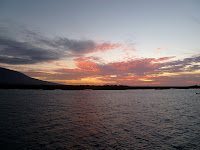 We sailed in to Tagus Bay past the most amazing volcanic caldera. Sea-horse shaped, Isabela is the largest and one of the youngest islands, located on the western edge of the archipelago, near the Galapagos hot spot. Approximately 1 million years old, the island was formed by the merger of 6 shield volcanoes - Alcedo, Cerro Azul, Darwin, Ecuador, Sierra Negra and Wolf. Five of the six volcanoes are still active (the exception is Ecuador) making it one of the most volcanically active places on earth, and two of lie directly on the equator - Ecuador and Volcán Wolf.
We sailed in to Tagus Bay past the most amazing volcanic caldera. Sea-horse shaped, Isabela is the largest and one of the youngest islands, located on the western edge of the archipelago, near the Galapagos hot spot. Approximately 1 million years old, the island was formed by the merger of 6 shield volcanoes - Alcedo, Cerro Azul, Darwin, Ecuador, Sierra Negra and Wolf. Five of the six volcanoes are still active (the exception is Ecuador) making it one of the most volcanically active places on earth, and two of lie directly on the equator - Ecuador and Volcán Wolf.Volcán Wolf is the youngest of Isabela's volcanoes and at 5,600 feet - the highest point in the Galapagos. The relatively new lava fields and surrounding soils have very low nutrient levels so is quite bleak in terms of vegetation. Galapagos Penguins and Flightless Cormorants feed from the Cromwell Current upwelling off the west coast of Isabela. These endemic birds nest along the coast of Isabela and neighboring Fernandina. The Mangrove Finch, Galapagos Hawk, Brown Pelican, Pink Flamingo and Blue Heron are among the birds who make their home here too.

After breakfast we took a panga and had a ride along the cliffs of Tagus Bay, looking at old graffiti, tuff cone formations and Galapagos Penguins (Spheniscus mendiculus - is the only penguin to live on the equator and can survive due to the cool temperatures resulting from the Humboldt Current and cool waters from great depths brought up by the Cromwell Current) - 20 or so swimming and diving alongside us!

We also saw spotting Flightless Cormorants (Phalacrocorax harrisi - only found on Isabela and Fernandina, and one of the rarest birds in the world ... maybe only 900 left)

Then - amazing - we watched while a sea lion smashed an octopus against the sea surface, killing &/or softening it; then devouring it. All yards away from our panga and our open mouths!

After our panga trip, I then went deep-water snorkelling - seeing 24 plus green sea turtles (Chelonia mydas - on the IUCN red list), and with sea lions (Zalophus wollebaeki).
Back for lunch on the top deck as we sailed for Fernandina Island and Punta Espinoza.Due to its recent volcanic activity, the island does not present much plant life and has a mostly rocky surface. Punta Espinoza is a narrow stretch of land where there are literally hundreds of marine iguanas gathered in large groups on black lava rocks.

After seeing a Galapagos Hawk (Buteo galapagoensis - it takes young marine and land iguanas, and sea turtle and tortoise hatchlings as prey. This predator has also been spotted near nesting areas of Swallow-tailed Gulls, where it steals eggs as well as young) and more marine iguanas, turtles and flightless cormorants, we returned to the ship where we enjoyed a super sunset.


No comments:
Post a Comment